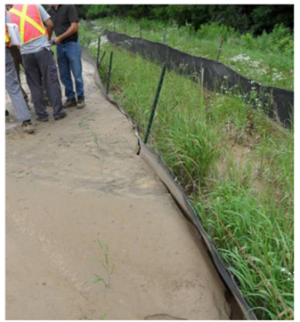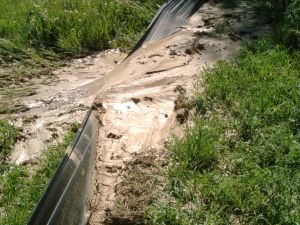Difference between revisions of "Construction: erosion and sediment control measures"
Kyle menken (talk | contribs) m |
Kyle menken (talk | contribs) m |
||
| Line 25: | Line 25: | ||
| | | | ||
*Leave vulnerable points with insufficient supports. | *Leave vulnerable points with insufficient supports. | ||
|[[File:ESC doubled up.png|300px|thumb|center|This sedidment fencing has been doubled up and staked in. As a result, it kept a large amount of sediment from entering the adjacent natural heritage feature. It is in need of immediate maintenance, however.]] | |[[File:ESC doubled up.png|300px|thumb|center|This sedidment fencing has been doubled up and staked in. As a result, it kept a large amount of sediment from entering the adjacent natural heritage feature. It is in need of immediate maintenance, however. (Photo source: CVC)]] | ||
|[[File:ESC insufficient support.JPG|300px|thumb|center|This sediment fencing was not staked in at the likely point of failure, resulting in the release of sediment into an adjacent natural heritage feature. (Photo Source: CISEC)]] | |[[File:ESC insufficient support.JPG|300px|thumb|center|This sediment fencing was not staked in at the likely point of failure, resulting in the release of sediment into an adjacent natural heritage feature. (Photo Source: CISEC)]] | ||
|- | |- | ||
Revision as of 14:54, 21 July 2022
Establish required perimeter controls, including erosion and sediment control (ESC) measures, prior to construction and adjust accordingly during construction. ESC measures come in two basic types: structural ESC, which slows and holds runoff from the disturbed area, dissipating erosive forces, promoting ponding, and allowing suspended particles to settle out; and non-structural ESC, which primarily minimizes the exposure time of stripped soils. STEP’s Erosion and Sediment Control Guide contains detailed guidance on the design, installation, inspection, maintenance, and decommissioning of ESC measures. This section gives simple, practical advice on structural and non-structural ESC for contractors, inspectors, and those who are new to construction and ESC practices. For non-structual ESC measures, be sure to:
- Stage clearing and grubbing to minimize exposure of stripped soils.
- Watch the weather and adjust plans accordingly.
- Manage and demarcate heavy equipment routes away from LID practices.
- Use simple, common-sense methods, such as scarifying exposed soils perpendicular to the grade to prevent the development of rills.
- Create and use a pollution prevention plan for any fuels or solvents.
Generally, all exposed soils that are not being actively worked on must have temporary erosion protection or permanent cover within 7 days for slopes 3:1 or greater and 14 days for slopes 3:1 or lesser and 14 days for slopes 3:1 or flatter. This should apply to all exposed soil areas year-round and until the site is stabilized.
The table below gives guidance on common mistakes made when installing structural ESC measures.
| Structural ESC measure | Do | Don't | (Pass) Photo Example | (Fail) Photo Example |
|---|---|---|---|---|
| Sediment fencing |
|
|
||
| Inlet controls |
|
|
Test |
Test |
| Stockpiles |
|
|
test | test |
| Filter fabric |
|
|
test | test
|

